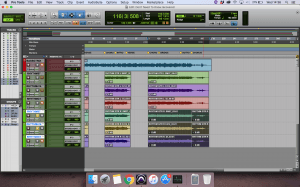Today’s lecture was given by Lucy Johnstone who is a freelance sound editor and re-recording mixer.
To begin, Lucy spoke to us in depth about some of the technical sides of recording voice overs and the best ways to capture and edit them. She suggested that some of the good ways to improve the overall sonic qualities of voice overs was to use VO trim, remove breaths and to remove lip smacks. She also recommended to use a small buffer size when recording voice overs to avoid echo and latency issues for the actor/narrator and that it is more important to spend more time on perfecting the dialogue as oppose to the SFX. In these scenarios, its 30% what you know and 70% how you are with client.
She also spoke to us about some of the other technical aspects of her job with regards to SFX, ambience and track laying/organisation. For ambience, she recommended that it’s best to have them in stereo so they can immerse the viewer, never loop the beginning of an ambience track, use different takes and clips for background sounds to prevent them from sounding repetitive and that Izotope RX can be a great tool to help match different takes and ambiences. For spot effects, it’s best to keep these in mono so it leaves you with more options and finally for track laying, she recommended putting tracks in banks of 4 or 8 to help organise the session. She also recommended that you ask the offline editor for handles, never cross two pieces of music and to speak to the director if you’re unsure whether they prefer long or short fades.
Aside from the technical side, she also gave some advice on how to get into the industry and what it can be like once you are in the industry. She suggested that work experience is crucial if you want to get a job in the industry and that finding small companies are good for moving up, however they may produce less high-profile shows. Working in house at these companies is also a great way to gain and experience and credits making it a lot easier if you decide to go freelance. This is also the route that Lucy took.
When working on a production, it’s important to fight your corner if you feel passionate about something however, at the end of the day it’s the director who makes the final decisions and knowing when to back down is important as you won’t be putting your job in jeopardy. A good thing to know is that dramas normally prefer to use boom mics and documentaries prefer clip mics with documentaries having a much faster turnaround of programs compared to drama.
I felt this lecture provided a great insight in the world of sound editing and re-recording within the industry, especially from a freelance perspective. The tips Lucy gave were very useful as freelance working is something i’m looking at once I leave University.

